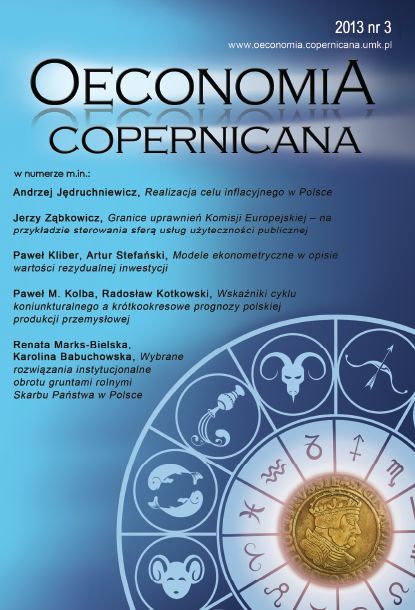Fulfillment of the Inflation Target in Poland
DOI:
https://doi.org/10.12775/OeC.2013.020Keywords:
inflation, inflation target, aggregate demand, wages, prices of raw materialsAbstract
Inflation is a fundamental category within an economy. Mainstream economists claim that its rate cannot be high nor too low, because it harms the economy. This is why today the basic aim of central banks is the maintenance of the increase of consumer prices on a low level. The main aim of the study is an evaluation of the level of fulfillment of National Bank of Poland?s inflation target that is fixed on the level of 2,5% annually with the accepted range of +/- 1 percentage point deviation. Main causes that were shaping the rate of real inflation were also specified. Research methods adopted in this paper are the deduction and the analysis of statistical indicators. In the period 2008-2011 the annual inflation in Poland was close to the inflation target only in 2010. In other years it was formed on the level around the higher border of the deviation range or above it. Main factors that influenced the increase of prices were: (1) changes in global demand ? they were strongly influencing the inflation rate after 4 quarters and the most important category of global demand was consumption; (2) changes in wages ? the increase of nominal wages was influencing the increase of prices mostly in the same quarter. After taking into account the changes of work efficiency, inflation reacted mainly after 4 quarters; (3) changes of prices of raw materials on world markets; (4) changes in the exchange rate of the zloty against the euro and the dollar. Their influence on consumer prices was also delayed.
Downloads
References
Balcerowicz L. (2013), Nikt nie rozliczył RPP za zbyt wysoką inflację, http://www.bankier.pl/wiadomosc/Balcerowicz-nikt-nie-rozliczyl-RPP-za-zbytwysoka- inflacje-2735177.html (stan na dzień 13 stycznia).
Begg, D., Fischer, S., Dornbusch, R. (2003), Makroekonomia, PWE, Warszawa. Biuletyn Statystyczny (2009-2012), GUS, Warszawa.
Błaszczyk P. (2010), Stabilność cen ? sposoby definicji oraz wyzwania dla polityki pieniężnej, Materiały i Studia, z. 249, NBP, Warszawa.
Butos W. N. (2006), Money, Prices, and Capital: An Austrian Approach to Macroeconomics, ?Quarterly Journal of Austrian Economics?, Vol. 9, No. 4, http://dx.doi.org/10.1007%2Fs12113-006-1020-2.
Ciżkowicz P., Rzońca A. (2009), Ile kosztuje nas inflacja?, Zeszyt FOR nr 8, Warszawa.
Commodity Markets (2013), http://econ.worldbank.org/WBSITE/EXTERNAL/E XTDEC/EXTDECPROSPECTS/0,,contentMDK:21574907~menuPK:7859231 ~pagePK:64165401~piPK:64165026~theSitePK:476883,00.html (17.01.2013).
Cukrowski J. (2003), Renta emisyjna i gospodarka finansowa banku centralnego, Wydawnictwo WSFiZ, Białystok.
Hayek F.A. von (1984), Intertemporal Price Equilibrium and Movements in the Volume of Money [w:] R. McCloughry (red.), Money, Capital and Fluctuations: Early Essays, Chicago.
Hazlitt H. (2007), Inflacja wróg publiczny nr 1, Fijorr Publishing, Warszawa.
Keynes J.M. (2003), Ogólna teoria zatrudnienia, procentu i pieniądza, PWN, Warszawa.
Kokoszczyński R. (2004), Współczesna polityka pieniężna w Polsce, PWE, Warszawa.
Kuttner K.N., Posen A.S. (1999), Does Talk Matter After All? Inflation Targeting and Central Bank Behaviors, Institute International Economics, September.
Kwartalne wskaźniki makroekonomiczne (2013), www.stat.gov.pl (11.01.2013).
Maliszewski W. (2001), Pomiar senioratu: przegląd metod i wyników empirycznych [w:] J. Cukrowski (red.), Renta emisyjna jako źródło finansowania budżetu państwa, CASE, Warszawa.
Mises L. von (2006), Ekonomia i polityka, Fijorr Publishing, Warszawa.
Mishkin F.S. (2000), Inflation Targeting for Emerging-Market Countries, ?American Economic Review?, No 3, http://dx.doi.org/10.1257%2Faer.90.2.105.
Misztal P. (2011), Główne determinanty inflacji w Polsce w latach 1997-2009, ?Optimum ekonomiczne?, nr 3(51).
Pacho W. (2002), Mikroekonomiczne koszty inflacji, Materiały i Studia, z. 138, NBP, Warszawa.
Polański Z. (1998), Wiarygodność banku centralnego a cele polityki pieniężnej, NBP, Stara Wieś.
Pollok A. (2000), Inflacja w teorii ekonomii, Wydawnictwo Akademii Ekonomicznej w Krakowie, Kraków.
Raport o inflacji (2009-2012), NBP, Warszawa.
Rocznik Statystyczny RP (2009-2012), GUS, Warszawa.
Rothbard M.N. (2010), Wielki Kryzys w Ameryce, Instytut Ludwika von Misesa, Warszawa.
Skousen, M. (2011), Struktura produkcji. Giełda, kapitał, konsumpcja, Fijorr Publishing, Warszawa. Sławiński A. (2011), Stabilizowanie inflacji [w:] A.
Sławiński (red.), Polityka pieniężna, C.H. Beck, Warszawa.
Sprawozdanie z wykonania założeń polityki pieniężnej (2009-2012), NBP, Warszawa.
Strategia polityki pieniężnej po 2003 r. (2003), NBP, Warszawa.
Svensson L.E.O. (2000), How should monetary policy be conducted in an area of price stability?, ?NBER Working Paper? nr 7516, Cambridge.
Szpunar P. (2000), Polityka pieniężna. Cele i warunki skuteczności, PWE, Warszawa.
Wojtyna A. (1998), Szkice o niezależności banku centralnego, PWN, Warszawa.
Wojtyna A. (2004), Szkice o polityce pieniężnej, PWN, Warszawa.
Ustawa z 29 sierpnia 1997 r. o Narodowym Banku Polskim, Dz. U. 1997, nr 140. www.nbp.pl
Zatrudnienie i wynagrodzenia w gospodarce narodowej w 2011 r. (2012), GUS, Warszawa.






